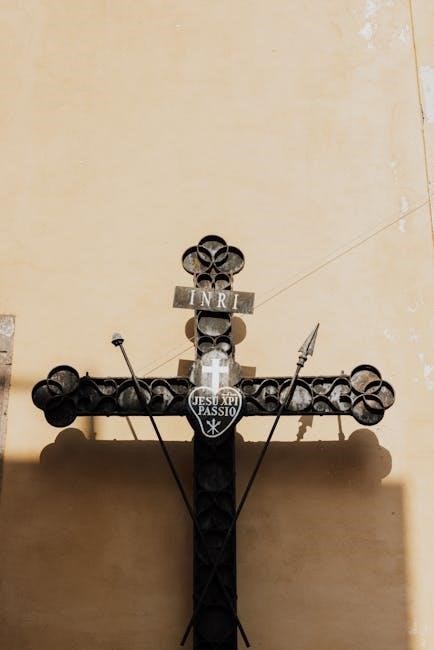
Passion Week, or Holy Week, commemorates Jesus’ final days, from Palm Sunday’s triumphal entry to Easter Sunday’s resurrection, highlighting redemption, sacrifice, and divine love.
1.1. Definition and Historical Context
Passion Week, also known as Holy Week, is the period commemorating Jesus Christ’s final days before His resurrection. It begins with Palm Sunday, marking Jesus’ triumphal entry into Jerusalem, and concludes with Easter Sunday, celebrating His resurrection. Historically, this week is rooted in biblical accounts from the four Gospels, detailing events such as the Last Supper, crucifixion, and resurrection. The term “Passion” refers to Jesus’ suffering and sacrifice, fulfilling Old Testament prophecies and establishing the foundation of Christian theology. This week is central to Christian faith, symbolizing redemption and divine love.

1.2. Significance in Christianity
Passion Week holds profound significance in Christianity as it encapsulates the core of the faith—Jesus’ sacrifice and resurrection. It symbolizes God’s love and redemption, fulfilling Old Testament prophecies. This period is a reminder of humanity’s salvation through Christ’s atonement, emphasizing themes of forgiveness, grace, and eternal life. For believers, it serves as a spiritual reflection on Christ’s mission and the triumph of life over death. The events of Passion Week are central to Christian theology and practice, shaping doctrines and inspiring devotion worldwide.

The Timeline of Passion Week

Passion Week, the final week before Easter, traces Jesus’ journey from the Triumphal Entry to His Resurrection, capturing pivotal events that underscore His mission and divine purpose.
2.1. Palm Sunday: The Triumphal Entry
Palm Sunday marks the beginning of Passion Week, commemorating Jesus’ triumphant entry into Jerusalem. Riding a donkey, He was greeted by crowds waving palm branches, symbolizing peace and victory. The event, recorded in Matthew 21:1-11, Mark 11:1-11, Luke 19:29-44, and John 12:12-19, signifies Jesus’ divine authority and fulfillment of prophecy. This day is a celebration of Jesus as the Messiah, setting the stage for the events leading to His crucifixion and resurrection. It is a powerful reminder of His mission to bring salvation to humanity.
2.2. Monday: The Cursing of the Fig Tree
On Monday of Passion Week, Jesus cursed a fig tree near Jerusalem, symbolizing spiritual barrenness and hypocrisy. This event, recorded in Matthew 21:18-22 and Mark 11:12-14, occurred as Jesus taught about faith and prayer. The withered fig tree mirrored the spiritual state of those who outwardly appeared righteous but lacked true devotion. This act underscored the importance of authenticity in faith, aligning with His earlier teachings in the Temple. The cursing of the fig tree serves as a powerful reminder of God’s expectation for fruitfulness and genuine spiritual life.
2.3. Tuesday: Jesus Teaches in the Temple
On Tuesday of Passion Week, Jesus returned to the Temple, where He delivered profound teachings, including the parable of the wicked tenants (Matthew 21:33-46, Mark 12:1-12). He confronted the Pharisees and Sadducees, challenging their spiritual hypocrisy and authority. Jesus also addressed questions about taxes, marriage, and the greatest commandment, emphasizing love for God and neighbor. His teachings underscored His divine authority, deepening the tension with religious leaders. This day highlighted Jesus’ role as a teacher and prophet, preparing His disciples for His impending sacrifice.
2.4. Wednesday: The Anointing at Bethany
On Wednesday of Passion Week, Jesus was in Bethany, where Mary anointed Him with costly perfume (Matthew 26:6-13, Mark 14:3-9, John 12:2-8). This act of devotion sparked controversy among the disciples, who criticized the expense, but Jesus defended Mary, stating the anointing prepared Him for burial. This intimate moment underscored themes of love, sacrifice, and preparation for His death. The event also highlighted the tension between extravagant worship and practical concerns, reflecting deeper spiritual truths about service and devotion.
2;5. Thursday: The Last Supper
Thursday of Passion Week marks the Last Supper, a pivotal moment where Jesus shared a final Passover meal with His disciples (Matthew 26:26-30, Mark 14:22-25, Luke 22:7-20). This intimate gathering in the Upper Room included Jesus washing the disciples’ feet, symbolizing humility and service. He instituted the Eucharist, breaking bread and offering the cup as representations of His body and blood, signifying the New Covenant. Jesus also foretold His betrayal and Peter’s denial, deepening the bond with His disciples before His arrest. This sacred event underscores themes of love, sacrifice, and spiritual renewal.

2.6. Friday: The Crucifixion
Friday marks the Crucifixion, the climactic event of Passion Week. Jesus, betrayed and condemned, was nailed to the cross at Golgotha, enduring immense physical and spiritual suffering. The crucifixion occurred at the third hour (9 AM), lasting until His death at the ninth hour (3 PM), when darkness covered the land. The veil of the temple tore, symbolizing access to God through Christ. Jesus’ final words, “It is finished,” sealed redemption. His body was buried by Joseph of Arimathea and Nicodemus, fulfilling prophecies and setting the stage for Sunday’s resurrection.
2.7. Saturday: The Sabbath Rest
Saturday, the Sabbath, marked a day of rest and anticipation. Jesus’ body lay in the tomb, guarded by Roman soldiers, while His disciples mourned and observed the Sabbath. This day, often called the “silent day,” held profound theological significance. It symbolized the rest of God’s plan, as the world waited for the promised resurrection. The stillness contrasted with the chaos of Friday, emphasizing the divine order of redemption. Saturday’s quiet anticipation prepared the stage for Sunday’s glorious resurrection, completing the redemptive act of Passion Week.
2.8. Sunday: The Resurrection

Sunday marked the pinnacle of Passion Week: Jesus’ resurrection. Early morning, women found the tomb empty, with angels declaring, “He is risen!” (Matthew 28:6; Mark 16:6). This triumph over death fulfilled biblical prophecies and demonstrated God’s power. Jesus appeared to His disciples, confirming His divinity and offering hope of eternal life. The resurrection symbolizes victory over sin and death, becoming Christianity’s cornerstone. It transformed grief into joy, forever altering human history and inspiring believers worldwide to celebrate Easter as a symbol of redemption and eternal hope;

Cultural and Religious Significance
Passion Week holds profound cultural and religious meaning, reflecting Jesus’ journey and resurrection, inspiring devotion and traditions worldwide, central to Christian faith and Easter celebrations.

3.1. The Jewish Calendar and Passover
The Jewish calendar aligns Passion Week with Passover, commemorating Israel’s liberation from Egypt. Jesus’ entry into Jerusalem coincided with the Feast of Unleavened Bread, symbolizing redemption. This historical overlap underscores the theological significance of Jesus as the Lamb of God, offering a new covenant of salvation. Passover traditions, such as the Seder meal, parallel the Last Supper, enriching the narrative’s cultural and spiritual depth.
3.2. The Role of Jerusalem
Jerusalem’s central role in Passion Week is profound, serving as the stage for Jesus’ triumphal entry, teachings, and ultimate sacrifice. The city’s temple was the focal point of Jewish worship, where Jesus challenged religious leaders, while its streets witnessed the procession of Palm Sunday and the solemn journey to Golgotha. Jerusalem’s historical and spiritual significance amplifies the events, making it a sacred location in Christian tradition and a symbol of redemption, drawing pilgrims and believers worldwide to reflect on these pivotal days.

Biblical References and Harmony
The four Gospels harmonize Passion Week events, with detailed accounts from Matthew, Mark, Luke, and John, providing a unified narrative of Jesus’ final days and resurrection.
4.1. Accounts from the Four Gospels
The four Gospels—Matthew, Mark, Luke, and John—provide complementary accounts of Passion Week, each offering unique insights. Matthew and John focus on theological significance, while Mark emphasizes action and Luke highlights human emotions. Harmonizing these accounts creates a comprehensive narrative, from the Triumphal Entry to the Resurrection. Each Gospel supports the others, ensuring a unified understanding of Christ’s sacrificial journey, essential for theological reflection and study of Holy Week.
4.2. Key Scriptures for Each Day
Each day of Passion Week is supported by specific biblical passages. Palm Sunday highlights Matthew 21:1-11 and John 12:12-19. Monday features the cursing of the fig tree in Mark 11:12-14. Tuesday includes Jesus’ teachings in Matthew 22-23. Wednesday focuses on the anointing at Bethany in Matthew 26:6-13. Thursday centers on the Last Supper in John 13. Friday’s crucifixion is detailed in John 19. Saturday’s rest aligns with Matthew 27:62-66, and Sunday’s resurrection is celebrated in John 20:1-10.

Practical Resources for Study
Downloadable PDF timelines and online Bible commentaries provide detailed Passion Week chronologies, enhancing study with visual aids and theological insights for deeper understanding.
5.1. Printable PDF Timelines
Printable PDF timelines offer a visual guide to Passion Week, detailing each day’s events from Palm Sunday to Easter. These resources include biblical references, historical dates, and locations, making them ideal for personal or group study. Many timelines are available online, providing a chronological breakdown of Jesus’ final week, from the Triumphal Entry to the Resurrection. They serve as valuable tools for understanding the sequence and significance of each event, enhancing both individual reflection and educational purposes.
5.2. Online Bible Verses and Commentaries
Online Bible verses and commentaries provide deeper insights into Passion Week, offering in-depth analysis of each event. Platforms like Biblegateway.com hyperlink verses, making it easy to explore biblical accounts. These resources enable users to follow the timeline from Palm Sunday to Easter, with detailed explanations of theological significance. Additionally, many websites offer downloadable PDF timelines that complement the digital tools, ensuring a comprehensive understanding of Jesus’ final week. These resources are invaluable for both personal study and group discussions, enriching the spiritual journey through Passion Week.